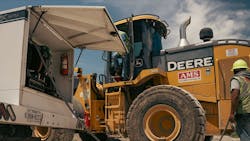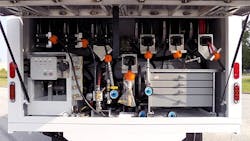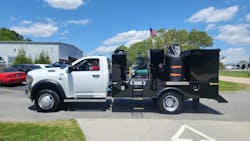Non-CDL Service Equipment Elevates Field Maintenance
More on field service
- Service truck average age inches up.
- Service on demand from a network of qualified technicians.
- How to maintain undercarriages.
- Dedicated lube truck ensures that service is up to date across a three-state region.
- How to maintain DEF quality.
- How to tackle fluid contamination.
In this article, you will learn:
- How some lube trucks avoid CDL requirements.
- Who are key suppliers of lube trailers and trucks.
- How one fleet successfully uses non-CDL equipment.
With today’s labor shortage in construction, it’s almost a given that the newest or most junior worker on site probably will not have a commercial driver’s license (CDL).
This can be a problem when there’s a sudden need to send someone to bring mobile lubrication or fuel across the job site, depending on the vehicles or trailers available.
Lube and service truck and trailer manufacturers have seen this trend—and other reasons to provide non-CDL options—and responded.
The traditional fuel/lube truck is a large tractor-style truck with a bed often featuring a fuel tank around 1,000 gallons in size, usually attached to a Class 7- or Class 8-sized chassis.
A CDL is required to operate a commercial vehicle above 26,000 pounds in weight, making it a necessity to lawfully operate a Class 7 or Class 8 commercial truck.
Commercial fuel and lube trucks now typically range in size from Class 5 to Class 8; each class covers vehicles with a specific gross weight range starting at 16,001 pounds. Class 5, for example, ranges from 16,001 to 19,500 pounds, while Class 8 includes anything over 33,000 pounds.
The fact that manufacturers have downsized and rearranged equipment on their truck bodies, as well as the existence of fuel and lube trailers, have allowed managers to spec smaller overall packages, avoiding the need for a CDL.
According to Sage Oil Vac, this has resulted in a number of advantages, including expansion of the labor pool, and easier-to-maneuver trucks as the smaller classes take more advantage of four-wheel drive.
There’s also the fact that smaller displacement engines consume less fuel, aiding operating costs. Finally, smaller truck and trailer packages are less of an upfront investment.
The type of service managers send trucks out to do can vary with a smaller lube package, and personnel can differ, too.
“[Being] under CDL allows them to do more of a targeted change, maybe a 500-hour service, whereas before they would try to fill up with filters and oil for a week,” Jeran Pollock, product manager with Stellar Industries, told Construction Equipment. “The idea is that you could have an inside tech actually jump in the vehicle and do the service.”
Suppliers of non-CDL service equipment
Thunder Creek Equipment’ VP of sales Larry Lea pointed out a potential issue of outsourcing lube services. “You could hire out some fueling and field service activities, but that puts you at the mercy of the schedules of other service providers,” he said. “That isn’t always convenient—particularly if your fleet operates on weekends, over holidays, or in remote areas.”
Here’s a look at some of what’s available for non-CDL-holder use.
Sage Oil Vac has a line of non-CDL lube truck bodies to fit in a Class 5/6 chassis, such as Dodge Ram 5500s or Ford F-550s. These Class 5/6 trucks have gross vehicle weight ratings ranging from 16,001 to 26,000 pounds.
A non-CDL lube truck body can transform the average truck into a heavy-duty maintenance vehicle with an array of industry applications. Sage Oil Vac fluid control panels are designed to make bulk fluid loading easy from ground level. From diesel generator maintenance to traditional fleet maintenance, a non-CDL lube truck body is economical and packaged for operator convenience, according to the company.
Avialable in enclosed and open lube bodies, the enclosed model (lube only) features eight product tanks, two Eberspächer diesel heaters, and a Miller CabEn heater.
The open lube body version, also for lube only, has a 180-gallon used oil tank and five product tanks.
Thunder Creek makes fuel and lube trailers for construction and agricultural applications. Its MTT 690 allows operators to transport bulk diesel without having a HAZMAT or a CDL, in many cases. The multitank solution has six separate, 115-gallon diesel fueling tanks connected to a commercial-grade pumping system via a common manifold.
Why AMC moved to a non-CDL service option
AMS Co., a Dallas-Fort Worth-based concrete, asphalt, excavation and soil stabilization contractor, has put an MTT 690 to work as part of its fueling efforts for 80 to 90 earthmovers and 25 to 30 trucks. Gary Gilliam is the GM in charge of maintenance.
"...When we got in the pinch with certified drivers, we thought this trailer is going to be the way it needs to go. And that was a good choice," Gilliam said.
“The trailer really broadens your pick of employees that we can have operate this machine and that helps,” Gilliam said. “If we've got a guy that understands the mechanics and stuff of doing PMs or fueling, we can put him in there and he can go to work today.”
Adding to the convenience of staffing is cost savings and efficiency.
“The overall cost of the trailer is much less than our previous fueling solution," Gilliam said. "When you go to buy a full-size truck, put the maintainer bed on it and a full fuel and lube bed, that's an expensive piece. But when you go back to this trailer, we cut our costs significantly right there.”
The Elliott and Stellar Industries Mini Lube Truck, recently introduced at World of Concrete, is designed for both CDL and non-CDL applications and offers a single-axle solution that can be used on and off the road.
Available in open or closed body styles, the truck carries four to five oil pumping systems, including systems for used oil, antifreeze, and grease. Custom-designed storage cabinets provide underbody storage.
A used oil evacuation system allows for rapid oil removal from machinery.
Taylor Pump & Lift manufactures non-CDL lube trucks with product tank options including new oil, waste oil, DEF and coolant, and grease (120-pound barrel).
Other makers such as Knapheide and American Eagle offer trucks or trailers that can be configured with smaller, lighter chassis to come in under CDL requirements.
About the Author
Frank Raczon
Raczon’s writing career spans nearly 25 years, including magazine publishing and public relations work with some of the industry’s major equipment manufacturers. He has won numerous awards in his career, including nods from the Construction Writers Association, the Association of Equipment Manufacturers, and BtoB magazine. He is responsible for the magazine's Buying Files.



